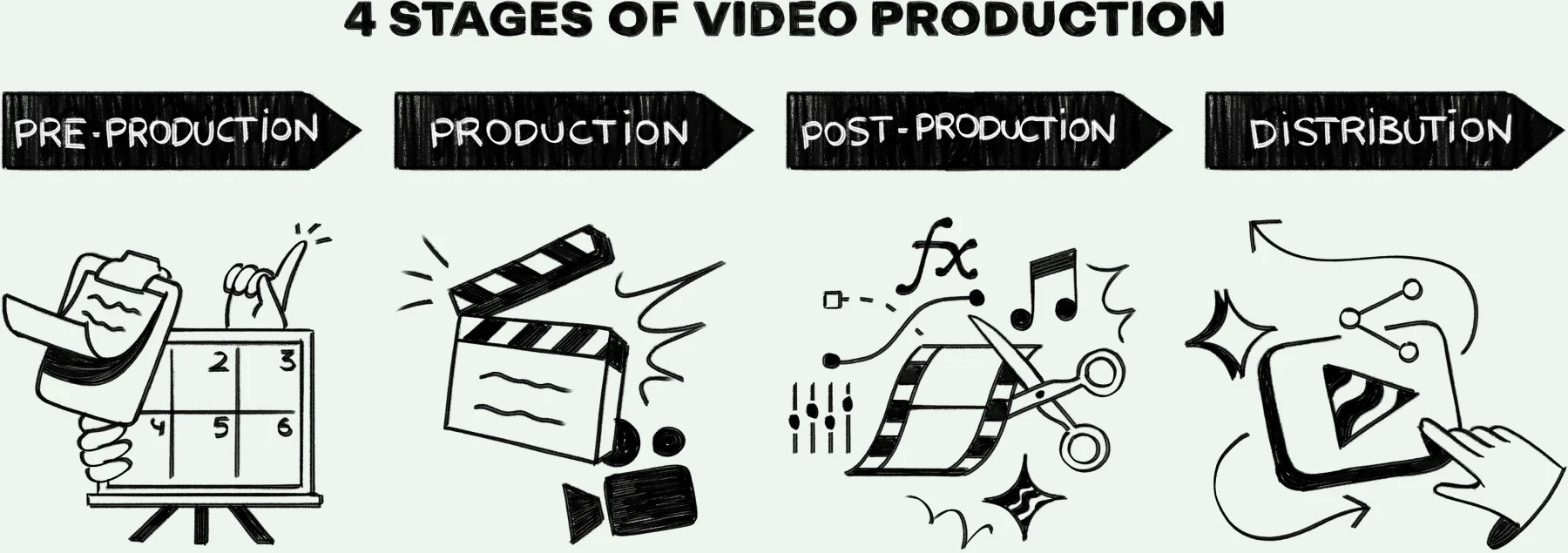In the dynamic world of content creation, video production stands as a powerful tool for storytelling, brand promotion, and audience engagement. Understanding the intricacies of each phase of video production is crucial for crafting compelling and successful video projects. From initial planning to final distribution, each stage plays a pivotal role in bringing your vision to life. In this blog, we’ll explore the four essential parts of video production and provide a step-by-step guide to help you navigate this creative process.
The Four Essential Parts of Video Production
When moving through your production, there are four critical areas to consider for success:

- Pre-Production: Laying the Foundation
Pre-production is where the magic begins, laying the groundwork for your entire project. It involves:
- Concept Development: Every great video starts with a solid idea. This is the phase where you brainstorm and refine your concept, ensuring it aligns with your goals and resonates with your target audience.
- Scriptwriting and Storyboarding: Once the concept is in place, the next step is to write a compelling script and create a storyboard. The script serves as the narrative backbone, while the storyboard helps visualize each scene, ensuring a cohesive and well-paced video.
- Planning and Scheduling: A well-organized shoot schedule and detailed planning are essential to avoid setbacks. This phase includes location scouting, securing permits, and creating a timeline that outlines every aspect of the production.
- Production: Bringing Ideas to Life
With pre-production complete, it’s time to move on to the production phase, where your ideas are brought to life:
- Filming and Directing: This is where the camera starts rolling. Filming involves capturing the raw footage according to your script and storyboard, with the director guiding the creative vision and ensuring everything runs smoothly on set.
- Lighting and Sound Setup: Good lighting and sound are crucial for professional-quality videos. Properly setting up lights and capturing clear audio can significantly enhance the overall production value.
- Capturing Raw Footage: The raw footage is the foundation of your video. Capturing high-quality footage with attention to detail ensures that you have the necessary material for a polished final product.
- Post-Production: Crafting the Final Product
Post-production is where the raw footage is transformed into a cohesive and engaging video:
- Editing and Special Effects: Editing involves cutting, arranging, and enhancing the footage to create a smooth and compelling narrative. Special effects can be added to elevate the visual impact.
- Sound Design and Mixing: Sound design includes adding music, sound effects, and voiceovers, while sound mixing ensures that all audio elements are balanced and clear.
- Color Correction and Grading: This process involves adjusting the colors to create the desired mood and ensure visual consistency throughout the video.
- Distribution: Sharing Your Creation
Once the video is complete, it’s time to share it with the world:
- Platforms and Formats: Choose the right platforms and formats to reach your target audience. Whether it’s YouTube, social media, or a corporate website, each platform has its own requirements.
- Marketing and Promotion Strategies: Effective marketing is key to ensuring your video reaches a wide audience. Develop a promotional plan that includes social media campaigns, email marketing, and SEO strategies.
- Audience Engagement: Engage with your audience through comments, feedback, and social media interaction. Building a community around your content can significantly boost its impact.
The Step-by-Step Guide to Video Production
Failing to plan is planning to fail, especially in video production. Here’s a step-by-step guide to ensure you have your ducks in a row before tackling your video production project.
Step 1: Initial Planning and Research
- Identifying the Target Audience: Understanding who your video is for will guide every decision in the production process.
- Setting Goals and Objectives: Clearly define what you want to achieve with your video, whether it’s brand awareness, lead generation, or education.
Step 2: Developing the Concept
- Creative Brainstorming: Gather your team for a brainstorming session to generate creative ideas that align with your goals.
- Creating a Treatment and Pitch: Develop a treatment that outlines your concept, and pitch it to stakeholders for approval.
Step 3: Scriptwriting and Storyboarding
- Writing a Compelling Script: A strong script is the heart of any video, providing structure and direction.
- Visualizing Scenes Through Storyboards: Storyboards help you visualize the flow of your video, ensuring that each shot aligns with the script.
Step 4: Production Planning
- Budgeting and Resource Allocation: Determine the budget and allocate resources effectively, considering factors like equipment, locations, and talent.
- Hiring Crew and Talent: Assemble a team of professionals who can bring your vision to life, including directors, camera operators, and actors.
Step 5: The Production Phase
- On-Set Filming Tips: Ensure a smooth shoot by following best practices, such as maintaining clear communication and staying on schedule.
- Managing Shoot Schedules: Stick to the planned schedule to avoid costly delays and ensure that all necessary footage is captured.
Step 6: Post-Production Workflow
- Editing Techniques: Use professional editing techniques to create a polished final product, including cutting, transitions, and effects.
- Integrating Visual and Sound Effects: Enhance your video with visual and sound effects that add depth and interest.
Step 7: Reviewing and Finalizing
- Quality Control Checks: Review the final product to ensure it meets all quality standards and aligns with the original vision.
- Client Feedback and Revisions: Allow time for client feedback and make necessary revisions before the final release.
Step 8: Distribution and Marketing
- Choosing the Right Platforms: Select platforms that best suit your target audience and content type.
- Creating a Promotional Plan: Develop a strategy for promoting your video, leveraging social media, email marketing, and SEO.
Corporate Videography: Elevating Your Brand
In today’s digital landscape, corporate videography has become a powerful tool for elevating your brand by effectively communicating your values, engaging key stakeholders, and showcasing your offerings. Let’s dive into the many sides of corporate videography.
The Role of Corporate Videos
- Building Brand Identity: Corporate videos help establish and reinforce your brand’s identity, communicating your values and mission to a broader audience.
- Engaging with Stakeholders: Use corporate videos to engage with employees, customers, and investors, building stronger relationships.
Types of Corporate Videos
- Training and Instructional Videos: These videos are designed to educate employees or customers, providing clear and concise information.
- Promotional and Marketing Videos: Showcase your products, services, or brand with promotional videos that attract and convert potential customers.
Best Practices for Corporate Videography
- Planning and Strategy: Develop a clear strategy for your corporate video that aligns with your business objectives and audience needs.
- Ensuring High Production Quality: Invest in high production quality to ensure your video reflects the professionalism and standards of your brand.
Navigating Production and Post-Production
Mastering the art of production and post-production is crucial for creating high-quality videos, and understanding how to navigate each stage effectively can make all the difference in bringing your vision to life.
Seamless Production Tips
- Efficient Shoot Planning: Plan your shoot meticulously to avoid any on-set surprises and ensure a smooth production process.
- Troubleshooting Common Issues on Set: Be prepared to handle unexpected challenges, from technical issues to last-minute changes.
Post-Production Essentials
- Organizing Footage and Assets: Keep your footage and assets organized for an efficient editing process.
- Streamlining the Editing Process: Use tools and techniques that streamline editing, saving time and maintaining consistency.
Effective Marketing Video Production
Every video you create should have a solid backbone of strategy. If it doesn’t your video may not resonate with the intended audience (or any audience for that matter). Let’s consider what it takes to effectively develop marketing videos.
Crafting Compelling Marketing Videos
- Understanding Your Audience: Know your audience’s preferences, pain points, and interests to create a video that resonates with them.
- Creating a Clear Message: Your video should have a clear, concise message that aligns with your marketing objectives.
Maximizing Reach and Impact
- Utilizing SEO Strategies: Optimize your video content for search engines to increase visibility and reach.
- Leveraging Social Media and Other Platforms: Distribute your video across multiple platforms to maximize its impact and audience reach.
Understanding the various stages of video production is essential for creating successful and impactful videos. By following the steps outlined in this guide, you can bring your creative vision to life, engage your audience, and achieve your project goals. Whether you’re producing corporate videos, marketing content, or creative projects, mastering these techniques will elevate the quality and effectiveness of your video production endeavors.




